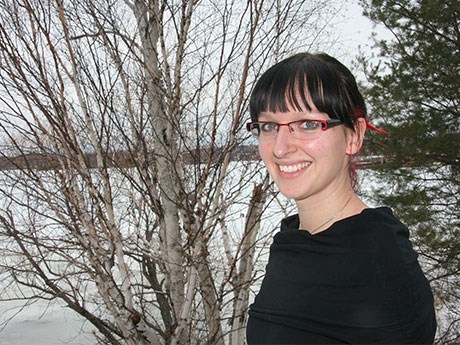Better understanding of microbial community can promote bioleaching in colder climates and mitigate risks associated with acid mine drainage
Nadia Mykytczuk, a research scientist at the Vale Living With Lakes Centre in Sudbury, has been awarded a Discovery grant by the Natural Sciences and Engineering Research Council of Canada to study the relationship between microbial communities and mine wastes.
Mykytczuk earned her PhD at Laurentian University studying the iron and sulfur oxidizing microbes that produce acid mine drainage.
Her current research expands on that work to also focus on other microbial species populating mine waste environments.
“The techniques we had available to us in recent years were very much limited to what we could culture in isolation in the lab,” she explained. “Now, with the advent of new molecular techniques, we can take an entire snapshot of the microbial community - potentially hundreds or thousands of microbial species.”
The objective is “to get a better understanding of the specific local microbial communities we have here and how they function at colder temperatures.”
Ultimately, she hopes to better understand how we can exploit the metabolic processes of iron and sulphur oxidizing microbes for bioleaching of mine waste or as a main extraction method for metals.
Her research will also focus on how we can control the metabolic process and stop the formation of acid mine drainage in areas where we’re not hoping to extract any more metals.
Iron and sulphur as well as other metals in mine waste are food sources for a whole family of microorganisms that oxidize the metals and produce acid mine drainage, which can, in turn, result in ecological destruction of watersheds and the contamination of human water sources by sulphuric acid and heavy metals.
Tailings
Mine wastes, or tailings, are a problem for all mining companies, said Mykytczuk.
“At the end of the mining cycle, they’ve already done a lot of the extraction and what’s left over are the various mine wastes. They can be deposited underground, under water or left in large waste deposits above ground. It’s the above ground deposits that are most prone to producing acid mine drainage because of the exposure to oxygen.
“Long after mining has concluded, you still have the environmental impacts of those mine wastes, so it’s important to be able to mitigate and control them.
“Exploiting and controlling the microbial community that’s present in the wastes is a win-win situation because a lot of the minerals that are left in the waste are low grade and can’t be removed through the traditional smelting process. Using microbes, we can extract those remaining metals while also lowering the sulphides present in the wastes and, thereby, eliminate a lot of the fuel for acid mine drainage.”
The value of the metals extracted can pay for the process.
“Not only do you have a saleable commodity, but what you’ve also done is reduce the reactivity of those wastes, so you can deposit them above ground with much less risk to the environment and reclaim the land through revegetation,” she noted.
If bioleaching isn’t of interest to a mining company, “we can populate the mine wastes with sulphate reducing organisms, which use the exact same iron and sulphur food sources but do the opposite of what the oxidizing microbes do, preventing acid mine drainage from occurring.”
Mykytczuk has had discussions with both Vale and the R&D Office at Cambrian College in Sudbury to build a small-scale leaching heap in the Copper Cliff tailings area and allow it to naturally leach for a year. The objective would be to provide a baseline and a better idea of how well bioleaching works in Sudbury’s colder climate.
Microbial processes tend to occur more slowly at colder temperatures, said Mykytczuk, but “many bacteria have adapted and prefer colder environments, so the more we understand the cold-adapted oxidizing bacteria, the more we can promote what they’re doing.”
Vale would be an ideal research partner, “because they have the largest deposits of mine wastes anywhere in Canada,” she noted.
Bioleaching, of course, isn’t new, observed Mykytczuk. It’s been going on for thousands of years. The Romans did it, and it’s widely used in warmer climates such as South America.
“It hasn’t caught on as much here because the mining industry has invested in the classical milling and smelting technology, and it’s very hard to have a parallel production line relying on bioleaching.
Bioleaching
“Bioleaching is also not the first choice for mineral extraction in Canada because it has not yet been demonstrated as a feasible alternative to the same extent as operations in warmer climates like South America.“ Sudbury, as a hub of mining in Canada, has the potential to be a leader in mining innovation, not only in the established mining technologies but also in mining alternatives such as bioleaching, she continued. “We have an abundance of mining wastes in Canada, and Ontario especially, that would be excellent targets for such an approach.”
Toronto-based BacTech Environmental Corp. takes another approach to bioleaching, processing mine tailings through a bioreactor.
“In an open environment, bioleaching would occur over a period of weeks or months, whereas in a controlled bioreactor, you can have turnover in a few days or a few weeks at most,” said Mykytczuk. “The bioreactor processes the tailings faster, but it means you have to build a small plant, which can be cost prohibitive.”



